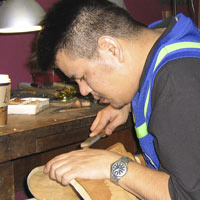Exploring Haida Art: Symbolism and Tradition
- Posted on
- By Cheryl's Trading Post
- 0

Haida art, renowned for its intricate designs and profound symbolism, represents the cultural heritage of the Haida people of the Pacific Northwest. This captivating form of art is more than just aesthetically pleasing; it is a vibrant narrative of history, tradition, and spirituality. In this article, we will delve into the fascinating world of Haida art, answering frequently asked questions and uncovering valuable insights that will deepen your appreciation and understanding of this unique artistic tradition.
What is Haida Art?
Haida art is the artistic expression of the Haida Nation, indigenous to the Haida Gwaii archipelago in British Columbia, Canada. This art form encompasses a wide range of mediums, including woodcarving, weaving, painting, and jewelry making. Characterized by its bold lines, complex patterns, and symbolic imagery, Haida art often depicts animals, mythical creatures, and ancestral spirits.

Alvin Adkins Gold Hummingbird Bracelet
The History and Significance of Haida Art
The roots of Haida art trace back thousands of years. Traditionally, Haida artists created pieces that served both functional and ceremonial purposes. Totem poles, arguably the most recognized form of Haida art, were erected to commemorate ancestors, tell stories, and signify clan lineage. The significance of Haida art extends beyond its visual appeal; it is a vital component of cultural identity and a medium through which the Haida people preserve and communicate their heritage.
Key Characteristics of Haida Art
Formline Design: The backbone of Haida art, formline design features continuous flowing lines that define the shape and structure of the artwork.
Ovoids and U-forms: These shapes are frequently used to create eyes, joints, and other body parts in Haida depictions of animals and humans.
Symbolism: Haida art is rich in symbolic meaning, often depicting animals that represent different traits and values. For instance, the Raven symbolizes transformation, and the Eagle represents power and prestige.
Frequently Asked Questions About Haida Art
Q: What materials are commonly used in Haida art?
A: Traditional Haida artists primarily used wood, especially red and yellow cedar, for carving totem poles, masks, and other items. Other materials include argillite (a type of stone), silver and gold for jewelry, and natural pigments for painting.
Q: How is contemporary Haida art evolving?
A: While traditional techniques and themes remain prevalent, contemporary Haida artists are incorporating modern materials and styles. This evolution allows for the preservation of cultural heritage while also adapting to contemporary artistic expressions.
Q: Where can one view authentic Haida art?
A: Authentic Haida art can be seen in various museums and galleries, such as the Haida Heritage Centre in Haida Gwaii, the Museum of Anthropology in Vancouver, and the Royal British Columbia Museum in Victoria. Additionally, many contemporary Haida artists sell their works through galleries and online platforms.
The Cultural Revival of Haida Art
In recent decades, there has been a significant revival of Haida art, driven by a broader movement to reclaim and celebrate indigenous cultures. This revival has been supported by initiatives to teach traditional art forms to younger generations, ensuring that these skills and stories are not lost. Events such as the Haida Gwaii Film Festival and art exhibitions have also played a pivotal role in bringing Haida art to a wider audience.
Notable Haida Artists
Haida artists have gained international acclaim for their work. Bill Reid is renowned for his masterful totem poles, jewelry and monumental sculptures. His work continues to inspire new generations of artists such as Jay Simeon, Corey Bulpitt and Reg Davidson.

The Future of Haida Art
As awareness and appreciation of indigenous art continue to grow, the future of Haida art looks promising. Educational programs and collaborations with international artists and institutions are helping to keep the art form vibrant and relevant. The blending of traditional techniques with modern innovations ensures that Haida art will continue to evolve while honoring its rich heritage.
Haida art is more than a visual delight; it is a profound expression of cultural identity and historical continuity. Whether you are an art enthusiast, a cultural historian, or someone seeking to understand indigenous traditions, exploring Haida art offers a glimpse into the soul of the Haida people. By appreciating and supporting this art form, we contribute to the preservation of a vital cultural legacy.





it varies a lot with which community it comes from. it might be a clan crest
it's the artists interpretation. it might be a clan symbol.
thanks. it's all available.